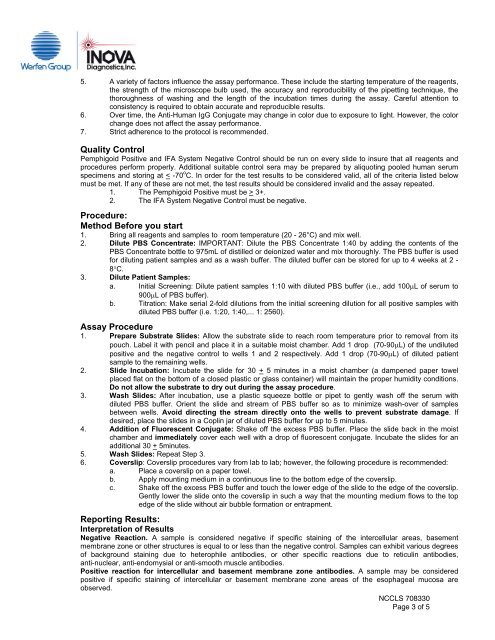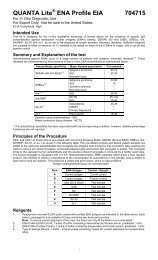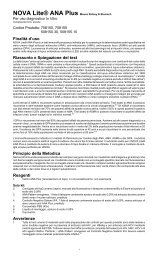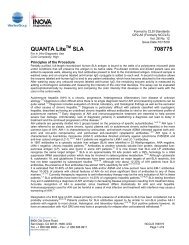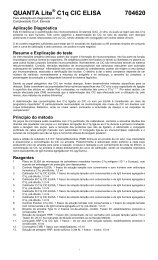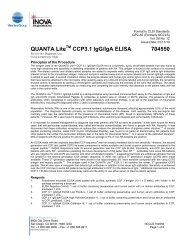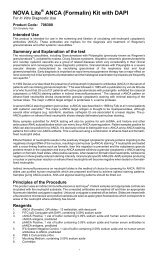NOVA Lite Skin Antibody 708330 - inova
NOVA Lite Skin Antibody 708330 - inova
NOVA Lite Skin Antibody 708330 - inova
Create successful ePaper yourself
Turn your PDF publications into a flip-book with our unique Google optimized e-Paper software.
5. A variety of factors influence the assay performance. These include the starting temperature of the reagents,the strength of the microscope bulb used, the accuracy and reproducibility of the pipetting technique, thethoroughness of washing and the length of the incubation times during the assay. Careful attention toconsistency is required to obtain accurate and reproducible results.6. Over time, the Anti-Human IgG Conjugate may change in color due to exposure to light. However, the colorchange does not affect the assay performance.7. Strict adherence to the protocol is recommended.Quality ControlPemphigoid Positive and IFA System Negative Control should be run on every slide to insure that all reagents andprocedures perform properly. Additional suitable control sera may be prepared by aliquoting pooled human serumspecimens and storing at < -70 o C. In order for the test results to be considered valid, all of the criteria listed belowmust be met. If any of these are not met, the test results should be considered invalid and the assay repeated.1. The Pemphigoid Positive must be > 3+.2. The IFA System Negative Control must be negative.Procedure:Method Before you start1. Bring all reagents and samples to room temperature (20 - 26°C) and mix well.2. Dilute PBS Concentrate: IMPORTANT: Dilute the PBS Concentrate 1:40 by adding the contents of thePBS Concentrate bottle to 975mL of distilled or deionized water and mix thoroughly. The PBS buffer is usedfor diluting patient samples and as a wash buffer. The diluted buffer can be stored for up to 4 weeks at 2 -8°C.3. Dilute Patient Samples:a. Initial Screening: Dilute patient samples 1:10 with diluted PBS buffer (i.e., add 100μL of serum to900μL of PBS buffer).b. Titration: Make serial 2-fold dilutions from the initial screening dilution for all positive samples withdiluted PBS buffer (i.e. 1:20, 1:40,... 1: 2560).Assay Procedure1. Prepare Substrate Slides: Allow the substrate slide to reach room temperature prior to removal from itspouch. Label it with pencil and place it in a suitable moist chamber. Add 1 drop (70-90μL) of the undilutedpositive and the negative control to wells 1 and 2 respectively. Add 1 drop (70-90μL) of diluted patientsample to the remaining wells.2. Slide Incubation: Incubate the slide for 30 + 5 minutes in a moist chamber (a dampened paper towelplaced flat on the bottom of a closed plastic or glass container) will maintain the proper humidity conditions.Do not allow the substrate to dry out during the assay procedure.3. Wash Slides: After incubation, use a plastic squeeze bottle or pipet to gently wash off the serum withdiluted PBS buffer. Orient the slide and stream of PBS buffer so as to minimize wash-over of samplesbetween wells. Avoid directing the stream directly onto the wells to prevent substrate damage. Ifdesired, place the slides in a Coplin jar of diluted PBS buffer for up to 5 minutes.4. Addition of Fluorescent Conjugate: Shake off the excess PBS buffer. Place the slide back in the moistchamber and immediately cover each well with a drop of fluorescent conjugate. Incubate the slides for anadditional 30 + 5minutes.5. Wash Slides: Repeat Step 3.6. Coverslip: Coverslip procedures vary from lab to lab; however, the following procedure is recommended:a. Place a coverslip on a paper towel.b. Apply mounting medium in a continuous line to the bottom edge of the coverslip.c. Shake off the excess PBS buffer and touch the lower edge of the slide to the edge of the coverslip.Gently lower the slide onto the coverslip in such a way that the mounting medium flows to the topedge of the slide without air bubble formation or entrapment.Reporting Results:Interpretation of ResultsNegative Reaction. A sample is considered negative if specific staining of the intercellular areas, basementmembrane zone or other structures is equal to or less than the negative control. Samples can exhibit various degreesof background staining due to heterophile antibodies, or other specific reactions due to reticulin antibodies,anti-nuclear, anti-endomysial or anti-smooth muscle antibodies.Positive reaction for intercellular and basement membrane zone antibodies. A sample may be consideredpositive if specific staining of intercellular or basement membrane zone areas of the esophageal mucosa areobserved.NCCLS <strong>708330</strong>Page 3 of 5


